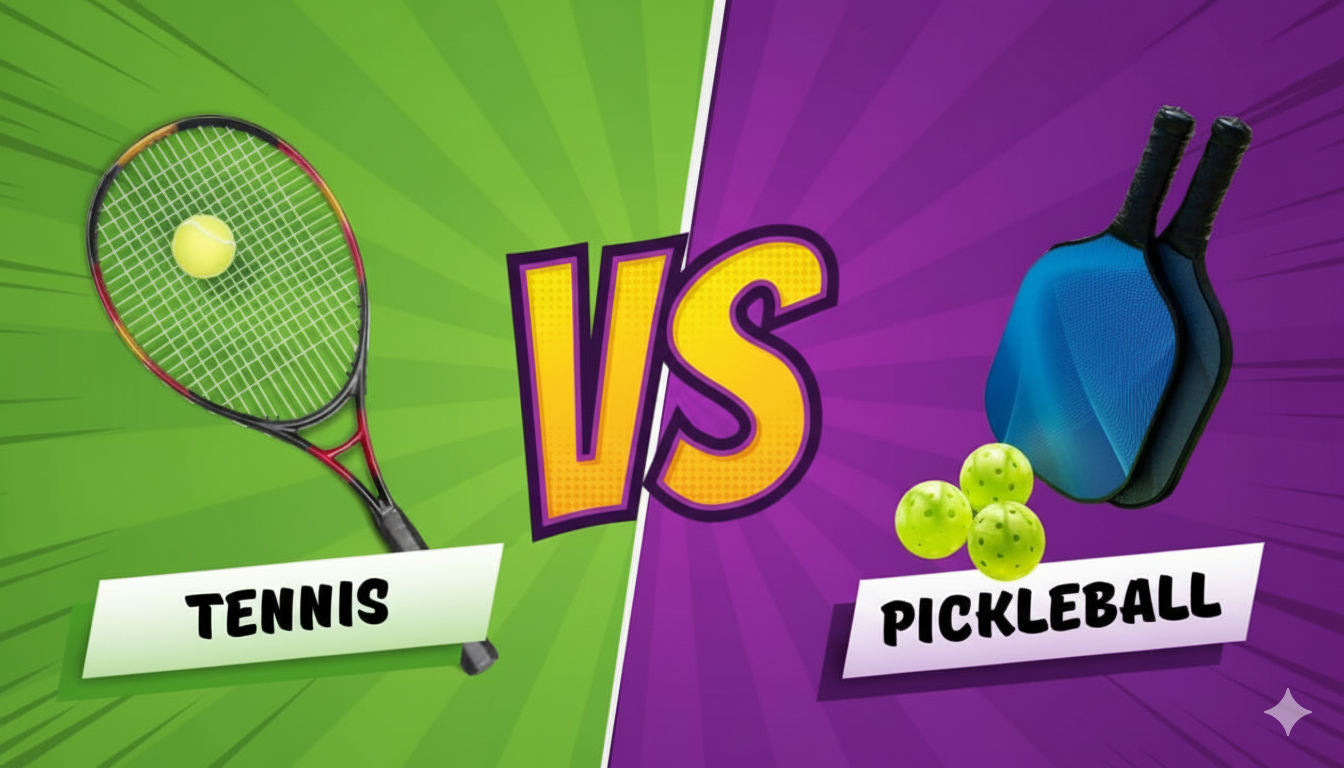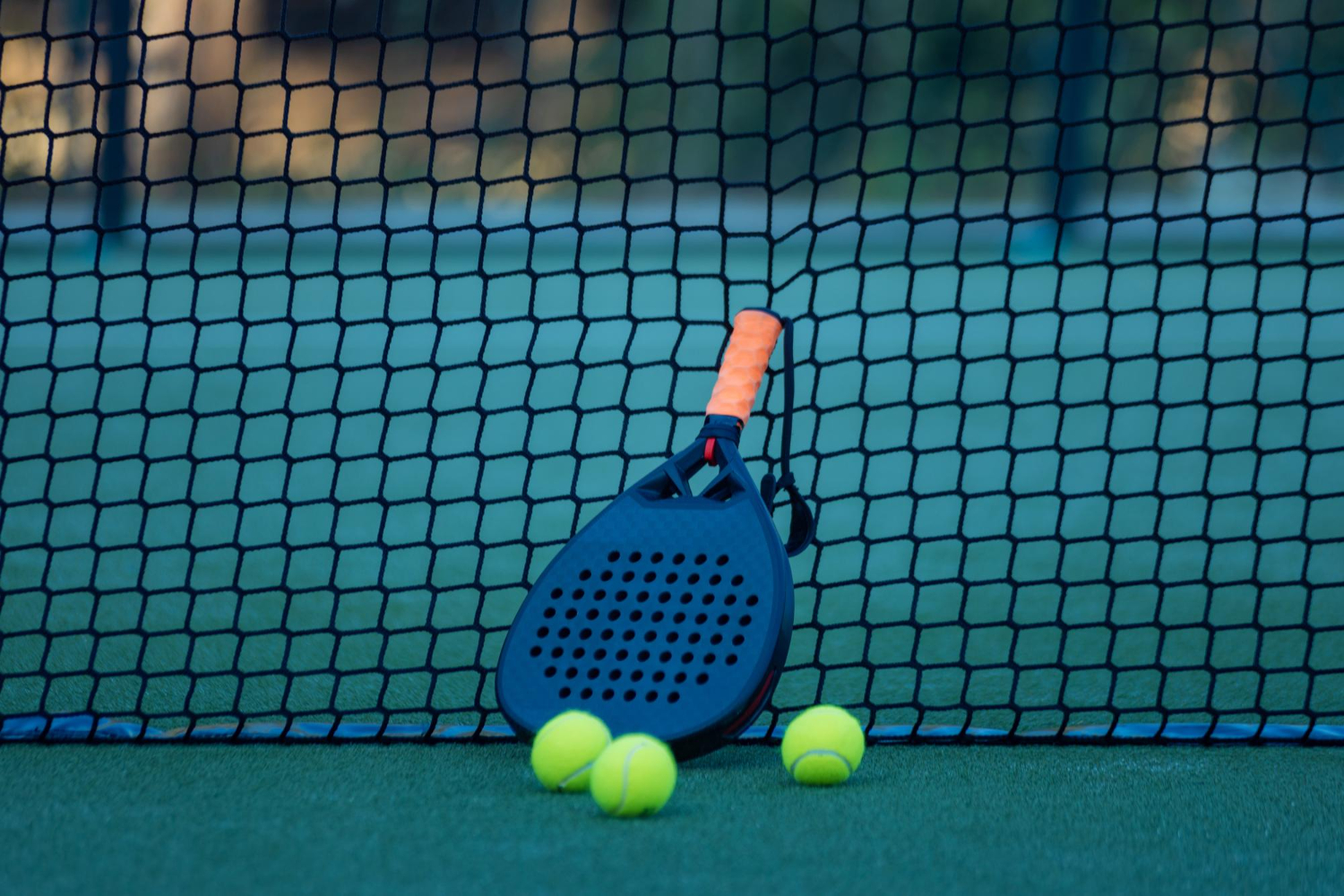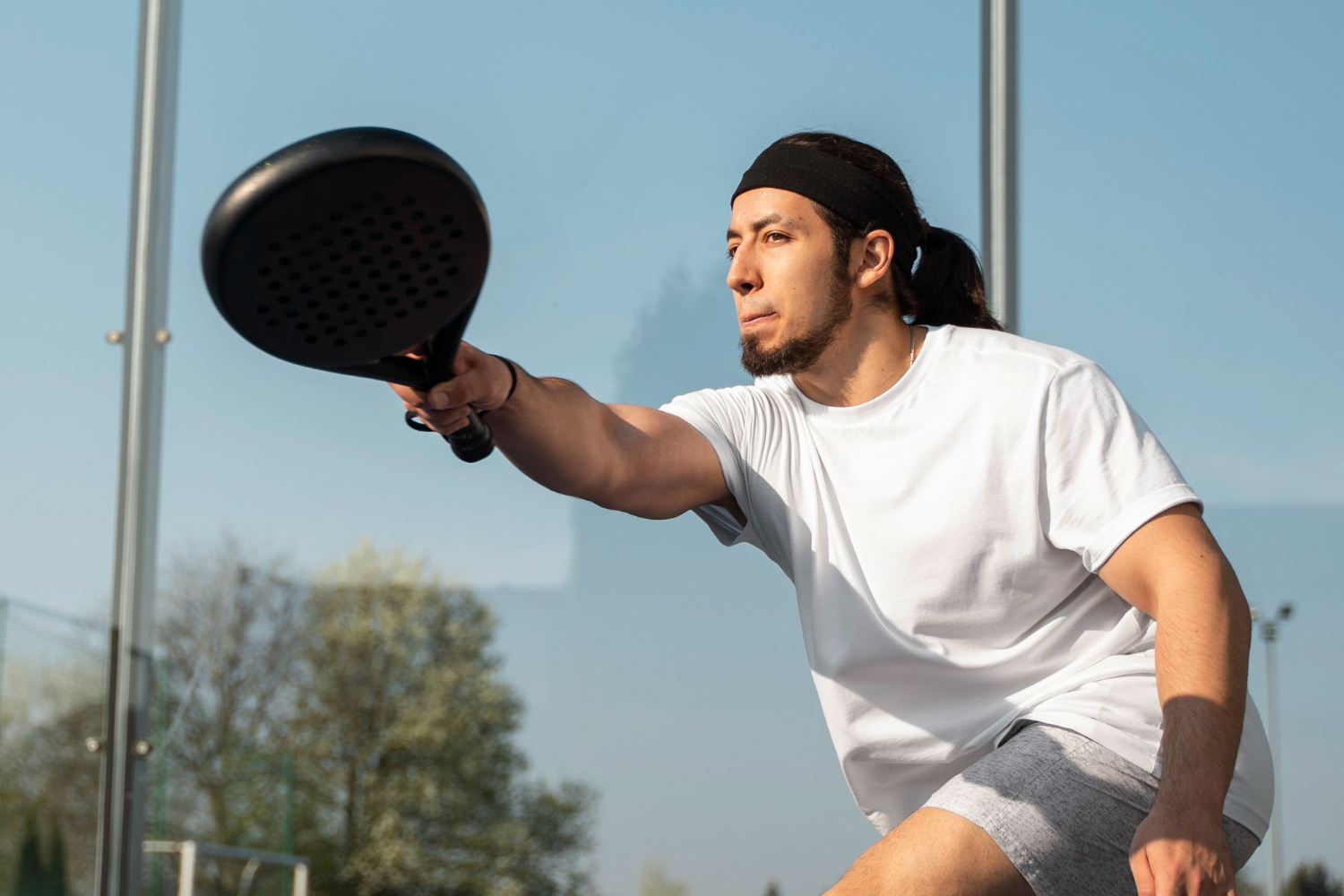Table of Contents
ToggleKey Takeaways
- Pickleball vs. Tennis Basics – How is tennis different from pickleball? While both sports share a net, court, and ball, pickleball blends elements of tennis, badminton, and ping pong, making it more accessible and easier to learn.
- Court Size – Pickleball courts are 44 ft × 20 ft for all formats, significantly smaller than tennis courts (78 ft long), allowing up to four pickleball courts to fit on one tennis court. This is how different pickleball is from tennis.
- Equipment Differences – Pickleball uses lightweight paddles (7–9 oz) and a perforated plastic ball, while tennis uses heavier, stringed rackets and felt-covered balls.
- Rules & Scoring – Pickleball serves are underhand and below the waist, with only the serving team able to score points (side-out scoring). Tennis allows overhand serves and rally scoring. A full guide is available via Pickleball Rules at Valley Athletics.
- Physical Demands – Tennis is more physically intense, with higher average heart rates (152 bpm vs. pickleball’s 143 bpm). Pickleball still provides a workout but is gentler on joints, making it suitable for all ages.
- Valley Athletics Advantage – Offers premium pickleball courts for both practice and competition, with membership or court booking options.
At first glance, pickleball and tennis may look similar; they both use a net, a court, and involve hitting a ball back and forth. But a closer look reveals significant differences in gameplay, equipment, court size, and intensity.
Often described as a fun blend of tennis, badminton, and ping pong, pickleball is easier to learn, accessible for all ages, and increasingly popular worldwide. Whether you’re a beginner or a seasoned athlete curious about trying something new, understanding how Pickleball is different from Tennis can help you choose the right game.
How Is Pickleball Different from Tennis? The Key Differences
While pickleball and tennis share some basic similarities, the differences are where the fun and the strategy lie. Here’s how the two sports stack up:
| Feature | Pickleball | Tennis |
|---|---|---|
| Court Size | 44 ft × 20 ft for singles & doubles | 78 ft × 27 ft (singles), 78 ft × 36 ft (doubles) |
| Equipment | Lightweight solid paddles (7–9 oz), perforated plastic ball | Stringed rackets (11–11.5 oz), felt-covered rubber ball |
| Serve | Underhand, below the waist | Overhand, often powerful |
| Scoring | Side-out scoring: only the serving team scores | Rally scoring: points can be scored by either side |
| Physicality | Emphasizes agility, reflexes, gentler on joints | Higher endurance, speed, and power required; more physically intense |
| Gameplay Feel | Slower pace, strategic rallies, beginner-friendly | Fast-paced, high-intensity, requires strength and stamina |
Court Size
- Pickleball: Smaller courts (44 ft × 20 ft) make the game space-efficient. You can fit up to four pickleball courts on one tennis court.
- Tennis: Larger courts (78 ft long) require more space and stamina to cover.
Equipment Differences
- Pickleball: Uses solid, lightweight paddles and a hollow plastic ball with holes. Ideal for players of all ages and skill levels.
- Tennis: Requires heavier stringed rackets and felt-covered rubber balls, designed for speed, spin, and power.
Rules: Serve & Scoring
- Pickleball:
- Serves must be underhand and below the waist.
- Side-out scoring: only the serving team can earn points.
- Tennis:
- Overhand serves allowed, often fast and powerful.
- Rally scoring: either side can score during a point.
Physical Demands & Intensity
- Tennis demands higher speed, endurance, and power. Average heart rates for players reach 152 bpm.
- Pickleball provides a solid workout while being gentler on joints (average 143 bpm). It emphasizes agility, quick reflexes, and strategy, making it suitable for all ages.
For a full guide, check Pickleball at Valley Athletics.
Why is Pickleball Growing in Popularity?
Pickleball is no longer just a niche sport, it’s booming globally:
- United States: Over 19.8 million players in 2024.
- India: 1,200+ courts across 20+ states, with growing participation.
Factors driving growth:
- Accessibility: Simple rules and minimal gear.
- Social Connection: Smaller courts promote interaction and community.
- Low-Impact Exercise: Easier on joints than tennis.
- Affordability: Inexpensive equipment; many parks offer courts.
- Fast-Paced Fun: Longer rallies and strategic gameplay on a smaller court.
Looking ahead, the outlook for pickleball is bright. As more municipalities invest in dedicated facilities and communities organize leagues, tournaments, and youth programs, the sport’s footprint is set to grow even larger. With its unique mix of social engagement, accessibility, and physical benefits, pickleball is well-positioned to remain one of the most popular recreational sports for years to come.
The best way to remember the rules is simple: play regularly. Whether you’re still learning the basics or refining advanced techniques, consistent practice will help the rules become second nature. If you’re looking for a place to practice or compete in pickleball singles, booking a court is an excellent choice.
At Valley Athletics, you can become a member or reserve a court to enjoy a premium pickleball experience. From honing your skills to challenging a friend in a competitive singles match, access to a high-quality court ensures every game is both enjoyable and rewarding.
FAQs
1. How is a Pickleball Court Different from a Tennis Court?
While both sports use a net and require serving diagonally, the court sizes are very different. A standard pickleball court measures 44 ft × 20 ft for both singles and doubles, while a tennis court is 78 ft long and 27 ft wide for singles (36 ft for doubles). Pickleball also has unique serving rules; serves must be underhand, hit below the waist, and land cross-court in the service area.
2. Why Might Someone Prefer Playing Pickleball Over Tennis?
If you are wondering how pickleball is different from paddle tennis, you need to know that, apart from the rules and court size, Pickleball appeals to players looking for a less physically intense alternative to tennis. It’s easier on the joints, making it ideal for older players or anyone managing physical limitations. Still, it offers a great workout that improves balance, agility, reflexes, and hand-eye coordination, without the heavy impact that tennis can bring.
3. How is Pickleball Different from Paddle Tennis?
The main differences are in the equipment and ball type. Pickleball uses a lightweight plastic ball with holes (similar to a wiffle ball) and solid paddles, while paddle tennis uses a depressurized tennis ball and perforated paddles. Pickleball courts are smaller, and the style of play emphasizes control and shot placement over raw power.
4. How is Pickleball Different from Tennis and Badminton?
Pickleball blends elements of both, but with its own distinct twist. It’s played on a smaller court than tennis, uses paddles instead of rackets, and the plastic ball bounces, unlike badminton’s shuttlecock. The pace is generally slower than badminton, making it beginner-friendly yet still competitive for experienced players.
5. Why Are Tennis Players Switching to Pickleball?
Many tennis players are drawn to pickleball’s accessibility, social atmosphere, and strategic gameplay. It’s easy to learn, fun at all skill levels, and less taxing physically, yet still offers opportunities for high-level competition and even professional careers.
Author
-
Sarah Baker is a dedicated sports and fitness content specialist with a rich background in athletics. As a former high school volleyball player and track athlete, she understands the transformative power of sports in shaping character and fostering discipline. Sarah is passionate about inspiring youth worldwide to embrace sports, hone their skills, and achieve excellence both on and off the court. She continually expands her knowledge through ongoing education in sports performance and fitness, aiming to empower her audience with valuable insights. Currently, Sarah contributes her expertise to the content team at Valley Athletics, a premier sports facility in Fresno, California, dedicated to developing young athletes in volleyball, basketball, and pickleball.
View all posts



